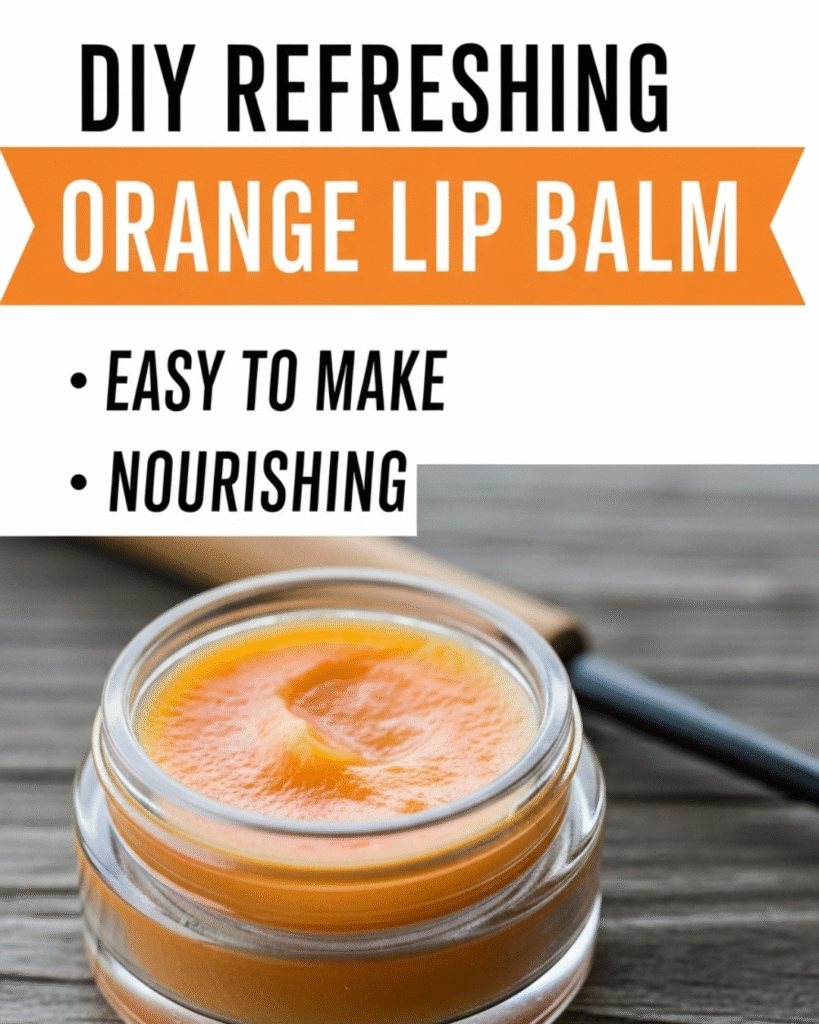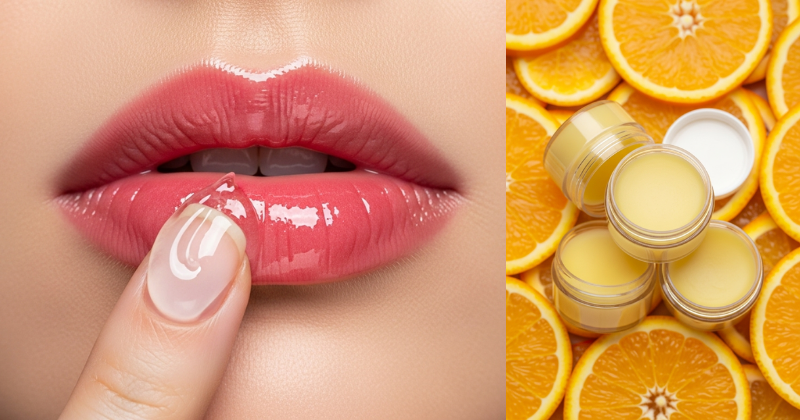Are you tired of dry, flaky lips and commercial balms filled with mysterious, chemical ingredients? It’s time to take control of your lip care routine and transform it with a handmade product you trust. Learning how to create a DIY REFRESHING ORANGE LIP BALM is a rewarding DIY project that emphasizes cost-saving benefits and the satisfaction of completion. This comprehensive guide will provide you with the achievable, step-by-step guidance necessary to discover the perfect balance of hydration, scent, and natural goodness, leaving you with plump, beautifully scented, and naturally vibrant lips.
Important Disclaimer: This article is for informational purposes only and should not replace professional advice. Individual results may vary, and personal circumstances should always be considered when implementing any suggestions.

🧪 Foundation First: The Perfect Lip Balm Formula
The secret to a successful, long-lasting DIY REFRESHING ORANGE LIP BALM is a precise ratio of three core components. Understanding this foundation will build confidence and allow you to easily customize your future batches.
H3: Key Components: Wax, Butter, and Oil
The ideal lip balm structure ensures stability (it doesn’t melt easily), spreadability (it glides on smoothly), and hydration (it locks in moisture).
| Component | Role in the Balm | Example Ingredient | Function |
| Wax | Provides structure and stability (high melting point). | Beeswax (or Candelilla Wax for vegan) | Gives the balm its solid shape and prevents melting. |
| Butter | Adds creaminess and deep conditioning. | Shea Butter or Cocoa Butter | Provides richness and deep hydration. |
| Oil | Adds slip, sheen, and moisture penetration. | Sweet Almond Oil or Jojoba Oil | Makes the balm spreadable and carries scent/vitamins. |
Encouraging Reassurance for Beginners: The ratio of these components (often $1:1:1$) is adjustable, but starting with equal parts is the easiest path to success!
H3: Addressing Common Concerns: Choosing Your Orange Scent
To get that refreshing orange aroma without irritation, you need to use essential oils safely, focusing on safety considerations right from the start.
- The Best Option: Sweet Orange Essential Oil: This is the safest citrus oil for topical use, offering a bright, sweet scent.
- The Caution: Phototoxicity: Certain citrus oils, like cold-pressed Bergamot or Lemon, can cause severe skin irritation and sun sensitivity (phototoxicity) when exposed to $\text{UV}$ light. Always use a steam-distilled or certified non-phototoxic oil if you choose to deviate from Sweet Orange, or apply only at night. For this DIY REFRESHING ORANGE LIP BALM, we stick with safe, cheerful Sweet Orange.
🍊 Section 2: Step-by-Step Process for Blending and Pouring
This method breaks down the creation of the balm into manageable, achievable steps using common kitchen tools.
Core Methods: The Melting and Mixing Process
Tool Requirements: Small digital scale (for accuracy), glass measuring beaker or small glass jar, small saucepan, stainless steel stirring spoon, and lip balm tubes or tins.
- Prep and Measure (Actionable Language): Use your scale to measure equal parts by weight of your Wax, Butter, and Oil.
- Example Recipe (Yields 10-12 tubes): 10g Beeswax, 10g Shea Butter, 10g Sweet Almond Oil.
- The Double Boiler (Safety Consideration): Never melt the ingredients directly over high heat. Create a double boiler by placing the glass measuring beaker (containing your measured ingredients) inside a saucepan that has 1-2 inches of simmering water.
- Melt the Heaviest First: Place the Beeswax and Shea Butter into the glass beaker first. Stir gently with the spoon until they are completely melted and liquid.
- Add the Oil: Once the wax and butter are liquid, remove the beaker from the heat and stir in the liquid oil (Sweet Almond Oil). The heat retained in the wax and butter will easily incorporate the oil.
- The Scent and Vitamin Boost: Wait 30 seconds for the mixture to cool slightly (if it’s too hot, it will degrade the essential oils). Add your essential oil and a touch of vitamin $\text{E}$ oil.
- Formula Shortcut: Add 10-15 drops of Sweet Orange Essential Oil and 1/2 teaspoon of Vitamin $\text{E}$ oil (acts as a preservative). Stir quickly.
- Quick Pour: Immediately and carefully pour the hot liquid balm into your empty lip balm tubes or tins. Timing and planning considerations: Work quickly! The mixture sets rapidly. Fill the containers just slightly over the top, as the balm will contract slightly as it cools, leaving a smooth surface.
- The Cool Down: Let the balms cool completely and solidify for several hours (or place in the fridge for 30 minutes) before capping.
🌈 Section 3: Advanced Strategies and Customization
Ready to move beyond the basic orange scent? These strategies encourage experimentation and personal adaptation of your DIY REFRESHING ORANGE LIP BALM.
H3: Creative Solutions: Adding Color and Shine
You can easily adjust the color and texture to achieve a more custom look, creating multiple options to suit different preferences.
- Natural Tint: For a subtle pink or red tint, scrape a small amount of an old lipstick (that you know is lip-safe) or a pinch of cosmetic-grade mica powder into the melted mixture before adding the essential oils. Start with a tiny amount—a little goes a long way!
- Extra Sheen: For a glossier finish, increase the proportion of the liquid oil slightly (e.g., use 8g Wax, 10g Butter, 12g Oil). This customization approach makes the final balm softer and more reflective.
- Flavor, Not Just Scent: Essential oils provide scent, but pure food-grade flavor oils (like vanilla or peppermint flavor oil) provide actual taste. Add flavor oil alongside the essential oil in Step 5.
H3: Pro Tips: Achieving the Ideal Texture
The texture of your balm changes based on the wax and butter used.
- Softer Balm for Cold Climates: If you live in a cold region where balms tend to get too hard, substitute some of the Beeswax with a softer wax, like Carnauba wax (use less, as it’s harder than Beeswax), or increase the liquid oil by $2-3$ grams.
- Firm Balm for Summer/Hot Climates: Increase the amount of Beeswax by $2-3$ grams. Beeswax is a natural heat shield and helps your DIY REFRESHING ORANGE LIP BALM withstand warmer temperatures without melting in your pocket. This addresses seasonal considerations.
🛑 Section 4: Troubleshooting Common Challenges
Even the simplest DIY projects can hit snags. These practical examples and real-world scenarios provide solutions for common texture and appearance issues.
Featured Snippet Potential: “Why is my DIY lip balm gritty after it cools?”
Your DIY lip balm is gritty after it cools because the Shea Butter crystallized during the cooling process. Shea butter contains fatty acids that separate when cooled slowly. To fix this setback, re-melt the entire batch quickly in the double boiler, stir well to ensure everything is liquid, and then place the still-liquid mixture in the freezer immediately for 10-15 minutes. Rapid cooling prevents crystallization, resulting in a smooth, creamy texture.
Practical Troubleshooting Tips (DIY Focus)
- Problem: The balm separates in the tube (looks oily at the bottom).
- Obstacle: Not stirring the mixture enough immediately before pouring, or pouring too slowly.
- Solution: Re-melt the batch. Stir constantly as you transfer the liquid from the double boiler to a small, pouring-spouted pitcher. Stir until the very last drop is poured. This provides troubleshooting for common issues.
- Problem: The Orange scent is barely noticeable.
- Obstacle: Citrus essential oils are highly volatile and evaporate quickly.
- Solution: Increase the Sweet Orange Essential Oil to 20 drops per 30 grams of total mixture, or pair it with a strong base note fixative like Vanilla Absolute (2-3 drops) to anchor the scent.
- Problem: Air bubbles formed at the top of the poured balm.
- Obstacle: Pouring the liquid too hot or from too high a distance.
- Solution: Encouragement for setbacks: Once the balm has cooled for a few minutes and a light skin has formed, gently puncture the bubbles with a toothpick. Allow the rest of the balm to cool, then re-melt a tiny amount of the leftover balm and use a dropper or syringe to fill the holes, providing a smooth finish (alternative approaches).
📈 Section 5: Maximizing Results: Next Level Lip Care
Once you master your DIY REFRESHING ORANGE LIP BALM, integrate it into a comprehensive lip care routine for maximum long-term benefits.
- Lip Scrub Complementary Strategy: The softest lips require exfoliation. Create a simple sugar scrub using 1 part Sweet Almond Oil and 2 parts fine sugar. Use the scrub twice a week, and follow immediately with a thick layer of your homemade orange balm. This builds upon your basic success. (Internal Linking Opportunity: For a deep dive into homemade scrubs, see our article, “DIY Sugar Scrub Recipes.”)
- Maintenance and Long-Term Considerations: Store your balms away from heat and direct sunlight to maintain the integrity of the natural oils and the stability of the wax. Because this is a natural, waterless product, it has a shelf life of up to 1 year, ensuring sustainable lifestyle changes.
- Inspire Continued Growth and Learning: Use your base recipe to experiment with other flavor profiles. Try a Lemon-Mint blend or a Clove-Ginger winter balm. The possibilities are endless when you understand the foundational ratio.
✅ Conclusion: Your Capability to Nurture Naturally
You have successfully learned how to make your own DIY REFRESHING ORANGE LIP BALM, proving that high-quality, personalized lip care doesn’t require harsh chemicals or high prices. By mastering the blend of wax, butter, and oil, you have unlocked the secrets to natural cosmetic creation.
Embrace the joy of crafting and the confidence that comes with knowing exactly what you put on your body. Your capability to nurture yourself naturally is truly empowering!
Which next-level tip—implementing the Lip Scrub Complementary Strategy or customizing your next batch with natural tint—will you tackle to elevate your lip care game?
